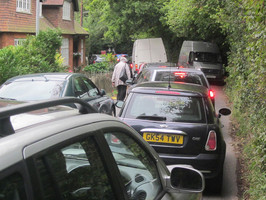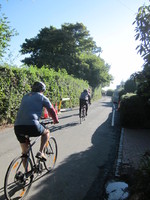
Wildlife
Since World War 2 the UK has lost 50% (250,000 miles) of it's hedgerows, and of that left only 60% are adequately managed.
The Climate Change Committee has advised that the UK needs to increase hedgerows by 40% to meet our 2050 net zero target, which means planting 120,000 miles of NEW hedgerows, and protecting and improving those that are left.
(Click here for a report on hedgerow loss).
When last surveyed (1995) some of the hedgerows in Cornford Lane were categorised as 'Species Rich , Intact', one of the highest designations.
There has never been a more important time to protect and preserve our hedgerows.
Cornford Lane has old and intact hedgerows and supports a large variety of wildlife as these surveys show:
Cornford Lane Hedgerow Evaluation and Grading System (HEGS)
Carried out by John Beesley August 1996
HEGS is a standard methodology for the ecological survey, evaluation and grading of hedgerows recommended within countryside planning and management to classify hedgerows into grades, according to their ecological value and habitat resource.
The grading scale used is intended to imply the following levels of ecological value:
Grade 1 High to Very High
Grade 2 Moderately High to High
Grade 3 Moderate
Grade 4 Low
Surveys were carried out on hedgerows in Cornford Lane and Halls Hole Road in August 1996 and a summary of the grades for Cornford Lane is tabled below.
|
Hedge Number |
Grade Number |
Hedge Length |
% of Total Length of Hedges |
|
1 and 6 |
1 |
600 and 60 |
29.2 |
|
3 |
-1 |
133 |
6 |
|
2 |
2 |
346 |
15.1 |
|
8 |
2 |
928 |
40.5 |
|
5 |
-3 |
50 |
2 |
|
4 |
4 |
42 |
1.9 |
|
7 |
-4 |
122 |
5.3 |
The table shows that 1,2,3,6 and 8 have moderately high to very high values and, having a combined length of 2075 metres form 90.8% of the total hedgerow length (2289 metres)
This value is, however, diminishing with heavy traffic in a narrow lane in the following ways:
- Noise prevents birdsong being effective in securing mates and defining territories in the pre-breeding season
- Fumes that effect birds, especially nestlings, more severely than humans
- Air disturbance and brushing of hedge fabric with vehicles make hedges unsuitable for nesting
- Bird-strike and animal casualties
- Destruction and reduction of roadside flora by wheels and brushing
Plants
|
Celandine |
Meadow Buttercup |
Creeping Buttercup |
|
||
|
Greater Celandine |
Hedge Mustard |
Lady's Smock |
|
||
|
Garlic Mustard |
Common Whitlow Grass |
India Balsam |
|
||
|
Perforate St John's Wort |
Imperforate St John's Wort |
Trailing St John's Wort |
|
||
|
Dog Violet |
Hairy Violet |
Ragged Robin |
|
||
|
Common Chickweed |
Lesser Stirchwort |
Greater Stitchwort |
|
||
|
Common Mouse Ear |
Procumbent Pearlwort |
Common Mallow |
|
||
|
Herb Robert |
Cut-Leaved Cranesbill |
Wood Sorrell |
|
||
|
Red Clover |
White Clover |
Bird's Foot Trefoil |
|
||
|
Greater Bird's Foot Trefoil |
Tifted Vetch |
Common Vetch |
|
||
|
Hairy Tare |
Common Vetch |
Meadow Vetchling |
|
||
|
Grass Vetchling |
Black Medick |
Barren Strawberry |
|
||
|
Tormentil |
Creeping Cinquefoil |
Agrimony |
|
||
|
Wood Avens |
Broad-Leaved Willowherb |
Greater Willowherb |
|
||
|
Enchanters Nightshade |
Dog's Mercury |
Common Nettle |
|
||
|
Wild Hop |
White Bryony |
Ivy |
|
||
|
Petty Spurge |
Cow Parsley |
Upright Hedge Parsley |
|
||
|
Ground Elder |
Hogweed |
Wood Dock |
|
||
|
Curled Dock |
Common Sorrel |
Primrose |
|
||
|
Scarlet Pimperel |
Lesser Periwinkle |
Greater Periwinkle |
|
||
|
Vervain |
Bindweed |
Bittersweet |
|
||
|
Black Nightshade |
Common Figwort |
Foxglove |
|
||
|
Field Speedwell |
Germander Speedwell |
Wall Speedwell |
|
||
|
Ivy-Leaved Speedwell |
Common Cow-Wheat |
Red Dead-Nettle |
|
||
|
Yellow Archangel |
Ground Ivy |
Hedge Woundwort |
|
||
|
Black Horehound |
Self Heal |
Bugle |
|
||
|
Woodsage |
Forget-Me-Not |
Green Alkanet |
|
||
|
Comfrey |
Ribwort Plantain |
Greater Plantain |
|
||
|
Honeysuckle |
Hedge Bedstraw |
Cleavers |
|
||
|
Teasel |
Colt's Foot |
Yarrow |
|
||
|
Dandelion |
Mugwort |
Spear Thistle |
|
||
|
Black Knapweed |
Lesser Burdock |
Nipplewort |
|
||
|
Rough Hawksbeard |
Prickly Sow Thistle |
Perennial Sow-Thistle |
|
||
|
Ox-Eye Daisy |
Black Bryony |
Cuckoo-Pint |
|
||
|
Bluebell |
Wild Garlic |
|
|
||
|
Black Spleenwort |
Common Spleenwort |
Male Fern |
|
Bracken |
Hart's Tongue |
Mountain Shieldfern |
|
Broad Buckler Fern |
Lady Fern |
Wall Rue |
Trees and Shrubs
|
|
||
|
Alder |
Field Maple |
Sallow/Goat Willow |
|
Ash* |
Field Rose |
Silver Birch |
|
Beech* |
Gorse |
Sweet Chestnut* |
|
Blackthorn* |
Hawthorn* |
Sycamore* |
|
Bramble |
Hazel* |
Wayfaring Tree |
|
Broom |
Holly* |
Wild Privet* |
|
Crab Apple |
Lime |
Willow |
|
Dog Rose |
Oak* |
Wych Elm |
|
Elder |
|
|
Mammals
|
Badger |
Fox |
Pygmy Shrew |
|
Bank Vole |
Hedgehog |
Rabbit |
|
Brown Rat |
Mink |
Stoat |
|
Common Shrew |
Mole |
Water Shrew |
|
Fallow Deer |
Pipistrelle Bat |
Wood Mouse |
|
Roe Deer |
Dormouse |
Weasel |
Birds
|
Blackbird |
Greenfinch |
Pied Wagtail |
|
Blackcap |
Greylag Goose |
Robin |
|
Blue Tit |
House Martin* |
Song Thrush |
|
Bullfinch |
House Sparrow |
Spotted Flycatcher* |
|
Canada Goose |
Lesser Whitethroat |
Starling |
|
Chaffinch |
Linnet |
Stock Dove* |
|
Chiffchaff |
Little Owl* |
Swallow |
|
Coal Tit |
Long-tailed Tit |
Tree Sparrow* |
|
Collared Dove |
Mallard |
Whitethroat* |
|
Dunnock |
Mistle thrush* |
Willow Warbler |
|
Garden Warbler |
Moorhen |
Wood Pigeon |
|
Goldcrest |
Nuthatch |
Wren |
|
Goldfinch |
Pheasant |
Yellowhammer* |
|
Great Tit |
Jackdaw |
Buzzard |
|
Cuckoo |
Kingfisher |
Sparrowhawk |
|
Fieldfare |
Magpie |
Swift |
|
Great Spotted Woodpecker |
Lesser Spotted Woodpecker |
Treecreeper |
|
Green Woodpecker |
Marsh tit |
Willow tit |
|
Grey Heron |
Redpoll |
Woodcock |
|
Jay |
Redwing |
Crow |
|
Kestrel |
Siskin |
Common Buzzard |
Cornford Lane Wildlife Survey 1996.pdf
Adobe Acrobat document [353.9 KB]


